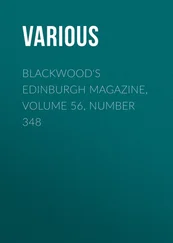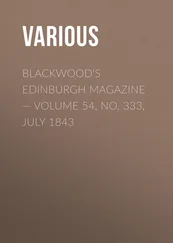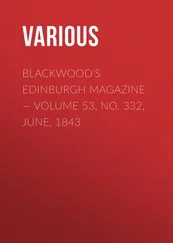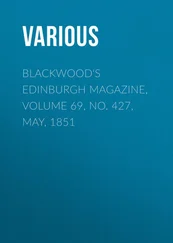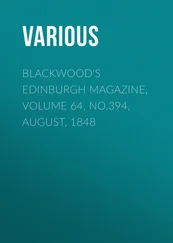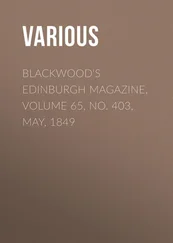Various - Blackwood's Edinburgh Magazine. Volume 55, No. 344, June, 1844
Здесь есть возможность читать онлайн «Various - Blackwood's Edinburgh Magazine. Volume 55, No. 344, June, 1844» — ознакомительный отрывок электронной книги совершенно бесплатно, а после прочтения отрывка купить полную версию. В некоторых случаях можно слушать аудио, скачать через торрент в формате fb2 и присутствует краткое содержание. Издательство: Иностранный паблик, Жанр: foreign_antique, periodic, foreign_edu, на английском языке. Описание произведения, (предисловие) а так же отзывы посетителей доступны на портале библиотеки ЛибКат.
- Название:Blackwood's Edinburgh Magazine. Volume 55, No. 344, June, 1844
- Автор:
- Издательство:Иностранный паблик
- Жанр:
- Год:неизвестен
- ISBN:нет данных
- Рейтинг книги:4 / 5. Голосов: 1
-
Избранное:Добавить в избранное
- Отзывы:
-
Ваша оценка:
- 80
- 1
- 2
- 3
- 4
- 5
Blackwood's Edinburgh Magazine. Volume 55, No. 344, June, 1844: краткое содержание, описание и аннотация
Предлагаем к чтению аннотацию, описание, краткое содержание или предисловие (зависит от того, что написал сам автор книги «Blackwood's Edinburgh Magazine. Volume 55, No. 344, June, 1844»). Если вы не нашли необходимую информацию о книге — напишите в комментариях, мы постараемся отыскать её.
Blackwood's Edinburgh Magazine. Volume 55, No. 344, June, 1844 — читать онлайн ознакомительный отрывок
Ниже представлен текст книги, разбитый по страницам. Система сохранения места последней прочитанной страницы, позволяет с удобством читать онлайн бесплатно книгу «Blackwood's Edinburgh Magazine. Volume 55, No. 344, June, 1844», без необходимости каждый раз заново искать на чём Вы остановились. Поставьте закладку, и сможете в любой момент перейти на страницу, на которой закончили чтение.
Интервал:
Закладка:
Fourthly, Has a body.
Fifthly, Is attenuate.
Sixthly, Is without proper station and function in the general economy of the universe; or is mythologically displaced.
Seventhly, Is endowed with powers of intelligence and of agency excelling human.
Eighthly, Stands under a doom.
To these eight criteria, taken in the nature of the thing enquired , the reflective inquirer will perchance find himself led on to add two furnished from within himself, as that—
First, Acknowledging, as in these latter days our more delicate psychologists have called upon us to do, the names fancy and imagination as designating two faculties, the fairies belong rather to the fancy.
Secondly, Accepting for a legitimate thought, legitimately and cogently signified, the High Marriage which one of these finer Metaphysicians 9 9 “Paradise and groves Elysian, fortunate fields—like those of old Sought in the Atlantic main, why should they be A history only of departed things, Or a mere fiction of what never was? For the discerning Intellect of man, When wedded to this goodly Universe In love and holy passion , shall find these A simple produce of the common day. I long before the blissful hour arrives Would chant, in lonely peace, the spousal verse Of this great consummation.” Wordsworth. Preface to the Excursion.
—instructed no doubt by his personal experience—prophesies to his kind, between the “intellect of man” and “this goodly universe,” we may say that, regularly, this marriage must have its antecedent possessing and agitating Love; that this love must, like all possessing agitated love, have its attendant Reverie. Now, might one venture to surmise that this reverie breathes into the creating of a fairy?
Does the jealous reader perchance miss in the above proposed eight several elements the unity of notion, which he has all along seemed to feel in his own spirit and understanding? Let him at once conceive, as intensely joined, the two permanent characters of tenuity and mythological displacement , and take this compound for the nucleus of the unity he seeks. About these two every other element will easily place itself. For a soul , he shall infuse into the whole, after in like manner inseparably blending them—fancy, and that love-inspired reverie which won its way to us from Grassmere.
And so take, reader, our answer to your question, “ What is a fairy? ” THIS is a Fairy. Are you still unsatisfied? Good. The field of investigation lies open before you, free and inviting. On, in your own strength, and Heaven speed you!
The eight or nine tales of sundry length, and exceedingly diversified matter, contained in the two little volumes of Herr Ernst Willkomm, 10 10 Sagen und Mahrchen aus der Oberlausitz . Nacherzahlt von Ernst Willkomm , Hanover, 1843.
which have put us a-journeying to Fairy-land, have begun to produce before the literary world the living popular superstitions of a small and hidden mountainous district, by which Cis Eidoran Germany leans upon Sclavonia: hidden, it would seem, for any thing like interesting knowledge, until this author began to write, from the visiting eye of even learned curiosity. Nor this without a sufficient reason; since the mountains do, of themselves, shut in their inhabitants, and, for a stranger, the temper of the rugged mountaineer, at once shy and mailing himself in defiance, is, like the soil, inaccessible. To Ernst Willkomm this hinderance was none. He discloses to us the heart of the country, and that of the people which have born him, which have bred him up; and he will, if he is encouraged, write on. Three of these tales, or of these traditions—for the titles, with this writer, appear to us exchangeable—regard the fairies properly so called. They are, “ The Priest’s Well ,” “ The Fairies’ Sabbath ,” here given, and “ The Fairy Tutor ,” being the first, the third, and the seventh, of the entire present series. Upon these three tales the foregoing attempt at fixing the generic notion of a fairy was intended to bear. Should pretty Maud, the stone-mason’s daughter, our heroine for to-day, find the favour in English eyes which her personal merit may well claim, the remaining two are not likely to be long withheld.
The illustrations which shall now follow, drawn from distinguished authorities, aim at showing the consonancy of Herr Willkomm’s pictures with authentic representations of Elfin superstition already known to the world. If, however, the criteria which have been proposed, have been rightfully deduced, the illustrations should as materially serve us in justifying these by proof.
Amongst the numerous points of analogy which strikingly connect our tale with popular tales and traditions innumerable, three are main to the structure of the tale itself. They may be very briefly described as—
I. The Heathenism of the Fairies.
II. Their need, thence arising.
III. Maud’s ability to help them.
I. The opinion, which sets the fairies in opposition to the established faith of all Christendom, is widely diffused. To the Breton peasant, as M. de la Villemarqué has above informed us, his Korrigan is a heathen princess, doomed to a long sorrow for obstinately refusing the message of salvation.
The brothers Grimm, speaking of the fairies in Ireland , say that “they are angels cast out from heaven, who have not fallen as low as hell; but in great fear and uncertainty about their future state, doubt, themselves, whether they shall obtain mercy at the last day.” 11 11 Irische Elfenmarchen: Uebersetzt von den Brüdern Grimm. Leipzig, 1826. Introduction.
Of the fairies in Scotland , it is averred by the same learned and exact writers, that “they were originally angels dwelling in bliss, but who, because they suffered themselves to be seduced by the archfiend, were hurled down from heaven in innumerable multitudes. They shall wander till the last day over mountains and lakes. They know not how their sentence will run—whether they shall be saved or damned; but dread the worst.”
Tales, in many parts of Europe, which represent the fairies as exceedingly solicitous about their salvation, and as inquiring of priests and others concerning their own spiritual prospects, for the most part with an unfavourable answer, tend to fix upon them a reproachful affinity with the spirits of darkness.
II. That the powerful fairies, who have appeared to us, from childhood upwards, as irresistible dispensers of good and evil to our kind, should need aid of any sort from us, is an unexpected feature of the fairy lore, which breaks by degrees upon the zealous and advancing inquirer.
The two excellent brothers Grimm, in the most elaborate and comprehensive collection, 12 12 Deutsche Sagen: Herausgegeben von den Brüdern Grimm. Berlin, 1816 and 1818.
probably, of national traditions that Europe possesses, have furnished us with various instances. We select a very few. In the following graceful Alpine pastoral, the need of human help attaches to an exigency of life or death:—
“A herd maiden found upon the fell a sick snake lying and almost famished. Compassionately she held down to it her pitcher of milk. The snake licked greedily, and was visibly revived. The girl went on her way; and it presently happened that her lover sued for her, but was too poor for the proud wealthy father, who tauntingly dismissed him till the day when he too should be master of as large herds as the old herdsman. From this time forwards had the old herdsman no luck more, but sheer misfortune. Report ran that a fiery dragon was seen passing o’ nights over his grounds; and his substance decayed. The poor swain was now as rich, and again sued for his beloved, whom he obtained. Upon the wedding-day a snake came gliding into the room, upon whose coiled tail there sat a beautiful damsel, who said that it was she to whom formerly the kind herd maid had, in strait of hunger, given her milk, and, out of gratitude, she took her brilliant crown from her head, and cast it into the bride’s lap. Thereupon she vanished; but the young couple throve in their housekeeping greatly, and were soon well at ease in the world.”
Читать дальшеИнтервал:
Закладка:
Похожие книги на «Blackwood's Edinburgh Magazine. Volume 55, No. 344, June, 1844»
Представляем Вашему вниманию похожие книги на «Blackwood's Edinburgh Magazine. Volume 55, No. 344, June, 1844» списком для выбора. Мы отобрали схожую по названию и смыслу литературу в надежде предоставить читателям больше вариантов отыскать новые, интересные, ещё непрочитанные произведения.
Обсуждение, отзывы о книге «Blackwood's Edinburgh Magazine. Volume 55, No. 344, June, 1844» и просто собственные мнения читателей. Оставьте ваши комментарии, напишите, что Вы думаете о произведении, его смысле или главных героях. Укажите что конкретно понравилось, а что нет, и почему Вы так считаете.

